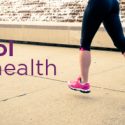New Physical Activity Guidelines

What if there was a free daily dose of medicine you could take to start improving your health immediately? A medicine so powerful and good for you that it could prevent or treat obesity, lower your risk of type 2 diabetes and high blood pressure, improve quality of life, and more. Would you take it?
If you said yes, you’ll be happy to learn that there is such a thing, and it can have all these benefits and more: physical activity! You can get started by sitting less and moving more with a moderate walk to your mailbox, skipping the elevator and walking a few extra flights of stairs, or even having a quick dance party in the living room with your family.
In November 2018, the Office of Disease Prevention and Health Promotion (ODPHP) released its new Physical Activity Guidelines for Americans 2nd edition. The overall message is to sit less and move more, and that all activity adds up. The benefits of being active are undeniable and attainable for everyone at all levels. A single session of physical activity can reduce blood pressure, improve insulin sensitivity, improve sleep, reduce anxiety symptoms, and improve some aspects of cognition on the day it is performed. These benefits become larger with a regular moderate-to- vigorous physical activity pattern.
Updated findings and recommendations
- Additional health benefits including for the brain and people who have cancer or fall-related injuries; as well as more generally how people feel, function, and sleep (both immediate and long term)
- More benefits for older adults and people with additional chronic conditions
- The risk of sedentary behaviors and their relationship to physical activity
- Guidance for preschool children ages 3 to 5
- Elimination of the requirement of at least 10-minute bouts of activity
- Population-based strategies that can be used to increase activity levels
Physical Activity Guidelines 2nd Edition key guidelines
Preschool-aged children (3-5 years old)
|
|
Children and adolescents (6-17 years old) |
Children should get 60 minutes or more of moderate-to-vigorous physical activity daily:
|
Adults |
Adults should move more throughout the day and sit less.
|
The latest guidelines also include more recommendations for older adults, women during pregnancy and the postpartum period, and adults with chronic health conditions and/or disabilities. They discuss how to meet guidelines, safety considerations, and partnering with a health care provider.
Eighty percent of Americans don’t get enough recommended physical activity. But this means there is a great opportunity to improve activity levels for people of all ages—and make a big difference. About half of all American adults have one or more preventable chronic diseases, and seven of 10 of the most common can improve through physical activity. These new guidelines have the potential to change our nation’s health and empower millions of Americans to start moving today!
References:
US Department of Health and Human Services (2018). Physical Activity Guidelines for Americans 2nd edition. Retrieved from: https://health.gov/paguidelines/second-edition/
Piercy, K. L., Troiano, R. P., Ballard, R. M., Carlson, S. A., Fulton, J. E., Galuska, D. A., … & Olson, R. D. (2018). The Physical Activity Guidelines for Americans. Jama.



